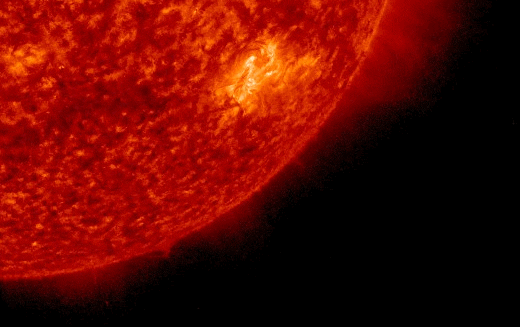SFI = 117
A index = 26
K index = 3
SSN = 83
GEOMAGNETIC STORM WATCH–DON’T GIVE UP: The past two days have had multiple geomagnetic storms–the result of a CME strike on Aug. 17th. None was as strong as the G3-class event originally forecast, but don’t give up! G1 and G2-class storms are still possible Aug. 19th, 20th, and 21st in response to additional CMEs on the way. High-latitude auroras remain likely as we enter the weekend.

that poses a threat for X-class solar flares.
Credit: SDO/HMI
THE EXPLOSIONS CONTINUE: In the past 24 hours, active sunspot AR3078 has produced four M-class solar flares and more than a dozen C-flares. Most of the explosions hurled debris into space. Here’s a sample C-class event at the end of Aug. 18th:

The blast was bookended by similar explosions hours earlier and later. The fusillade could cause additional grazing CME impacts here on Earth Aug. 20th and 21st, extending the ongoing spate of geomagnetic activity.
NOAA STI
:Product: Geophysical Alert Message wwv.txt
:Issued: 2022 Aug 19 0605 UTC
# Prepared by the US Dept. of Commerce, NOAA, Space Weather Prediction Center
#
# Geophysical Alert Message
#
Solar-terrestrial indices for 18 August follow.
Solar flux 117 and estimated planetary A-index 26.
The estimated planetary K-index at 0600 UTC on 19 August was 3.
Space weather for the past 24 hours has been minor.
Geomagnetic storms reaching the G1 level occurred.
Radio blackouts reaching the R1 level occurred.
Space weather for the next 24 hours is predicted to be moderate.
Geomagnetic storms reaching the G2 level are likely.
NOAA Alerts
Space Weather Message Code: ALTTP4
Serial Number: 566
Issue Time: 2022 Aug 19 0635 UTC
ALERT: Type IV Radio Emission
Begin Time: 2022 Aug 19 0457 UTC
NOAA Space Weather Scale descriptions can be found at
www.swpc.noaa.gov/noaa-scales-explanation
Description: Type IV emissions occur in association with major eruptions on the sun and are typically associated with strong coronal mass ejections and solar radiation storms.
